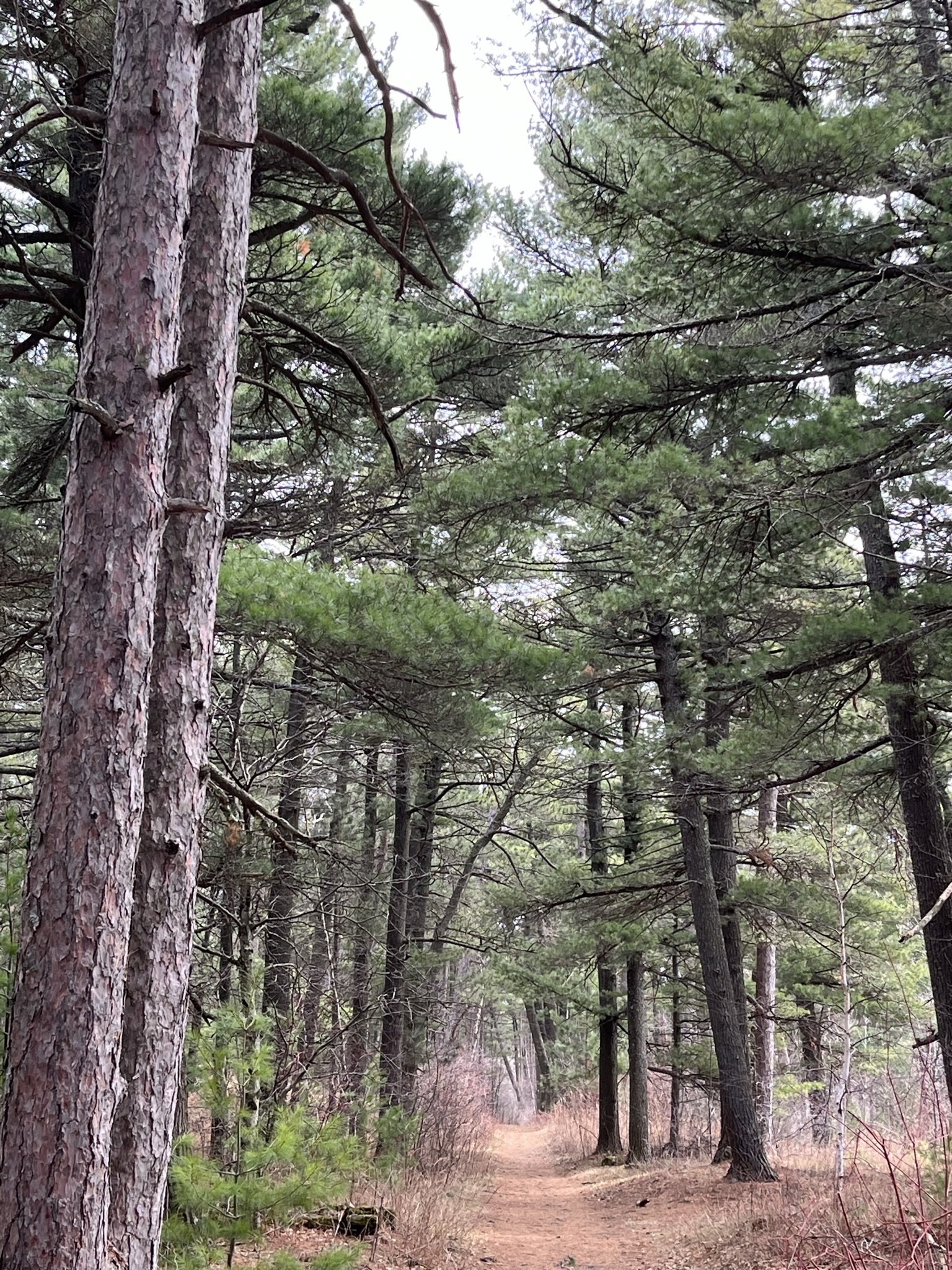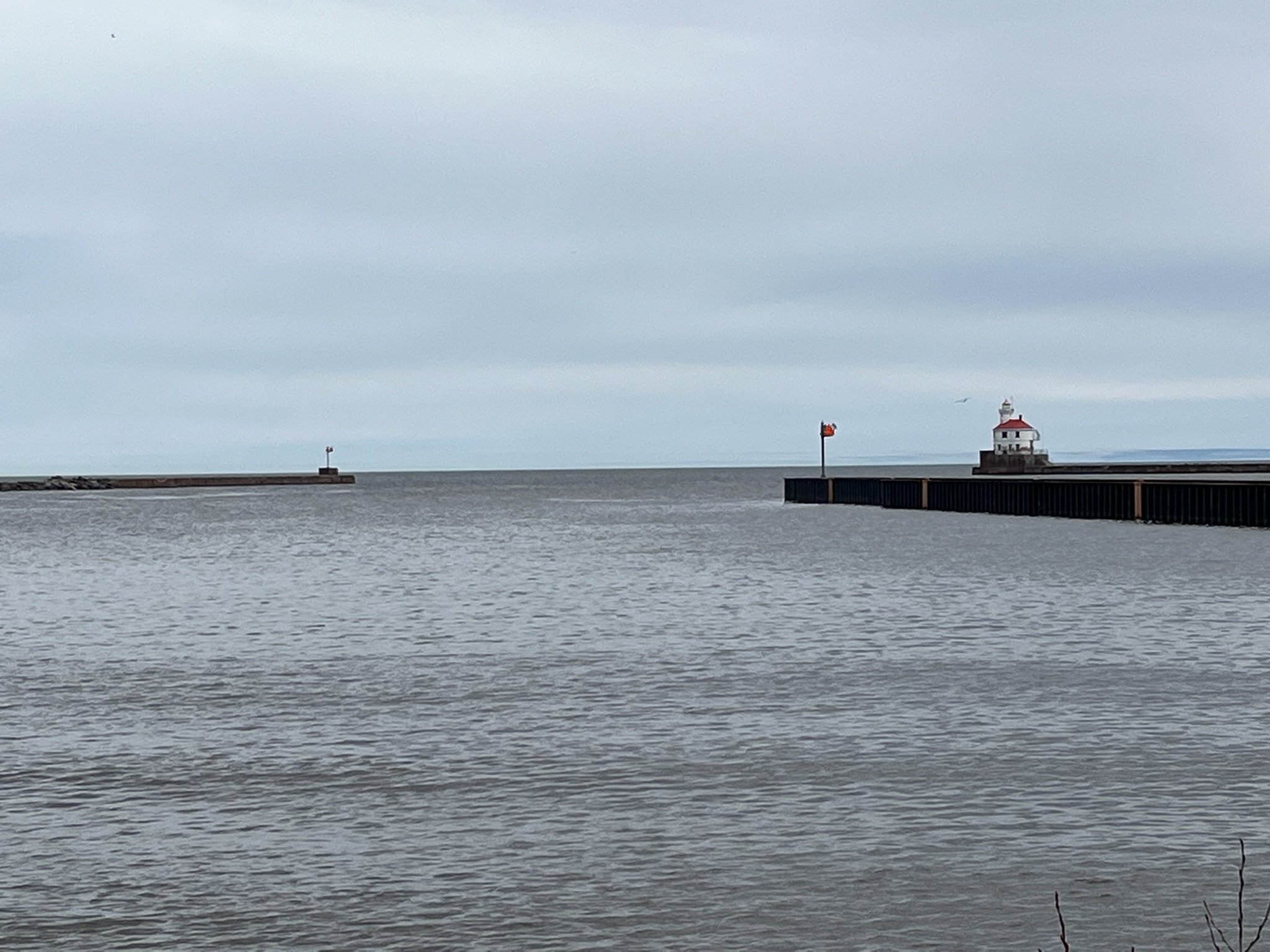-- *meaning “long, narrow point”
I fell in love with the 7-mile long, thin stretch of land that creates the Duluth harbor from the moment I first found it, soon after moving to Duluth in 1980. Here my dogs, who’d come from farm country into the city, could finally run free. They loved running up and down the beach and swimming out to fetch driftwood sticks we’d throw into the lake. I, too, loved running barefoot on the sand and jumping into the clear, cold waters of Superior. In the early mornings, I often found myself the only one on the beach, which amazed me in this city of nearly 90,000.
I’ve had wonderful times swimming, playing, and picnicking there. And in the time before fires on the Point were banned, in the evenings we’d sit around driftwood fires and watch the stars come out.
In the winter, huge ice cliffs form along the shore, built up for months by the crashing waves.
At the far end of the point grows a large pine forest – home to the eagles that nest in the tall pines, as well as the occasional fox. A trail through the forest leads past the old, original lighthouse and then on to the shipping canal between Minnesota and Wisconsin.
I also have loved the quirky mix of old and new houses that give such character to the Park Point neighborhood, known for its close-knit community with its annual rummage sale and art fair and its concern for the fragile beach ecosystem and the surrounding waters.
Lately this has begun to change. A motel was built on the Point just past the Lift Bridge, and more and more homes were bought up and turned into McMansions, Air BnB’s, and other vacation rentals. Then came Kathy Cargill, married to one of the heirs of the Cargill fortune.[i] Over the past several months, through her North Shore LS LLC, Cargill has bought up more than a dozen homes on the Point for two to three times their market value, and then razed them and all the surrounding trees and vegetation to the ground. In December, Cargill told the Duluth News Tribune that the demolished houses were "pieces of crap" that she couldn't imagine living in.[ii] Cargill refused to answer multiple queries about her intent for the properties, causing quite a bit of concern among Duluth residents, who feared that they might be planning “to turn an entire neighborhood full of public parks and public beaches into some sort of weird gated community for future billionaires to ride out the coming climate crisis in [so-called] "Climate-Proof Duluth",”[iii] closing access to the beach and changing the nature of the community into a mini-Minnetonka (home to the Cargill Corporation) where the median income necessary to purchase a single-family home is $500,000.
It wouldn’t be the first or the last time something like that has happened. Decades ago, the wealthy Dayton family purchased acres of prime Lake Superior shoreline just north of Two Harbors near the Encampment River, gating off public access to the lake there. The billionaire Uhilein family, owners of the Uline packaging supply company, bought up most of the town of Manitowosh Waters, Wisconsin where they spent millions remaking the small community in the image they preferred. I’ve witnessed the same in the quaint, small village on the lake in Michigan where I spent summers as a child, when former defense contractor, Jonathan L. Borisch and his son, Matt, bought up most of the property in the town, demolished most of the buildings, and built restaurants, retail stores, a high-end grocery store, and condominiums, luring the wealthy to the area where one-by-one they are tearing down old cabins and putting up McMansions, pricing long-time residents out of their homes.
Kathy Cargill finally broke her silence a few days ago, telling the Wall Street Journal that she planned to “beautify” the area, build homes for some relatives, open a coffee shop, fund “improvements” to city parkland as well as a sports facility. However, faced with growing concern and criticism from the residents and the city government, she had changed her mind. Calling the citizens of Duluth “small-minded,” she stated, "’The good plans that I have down there for beautifying, updating and fixing up Park Point . . . forget it.”[iv]
Perhaps Kathy Cargill had only the best intentions for the land she has bought up on Park Point. It is rumored that, like her now deceased mother-in-law, she may have been talking with the Nature Conservancy about some of the land. A friend whose knowledge and perspective I deeply respect has assured me that Ms. Cargill, who spent much of her life working for the Wisconsin DNR, has been a life-long environmentalist, and is relatively new to wealth, having married James Cargill after he lost his first wife to cancer in 2010. But as I’ve watched this saga unfold and witnessed the devastation on Park Point, I couldn’t help but see the parallels between Cargill’s behavior and the attitude and practices of the Cargill corporation around the world. Minnesota-based Cargill, the largest privately-owned corporation in the world and the primary purchaser and distributor of grain throughout the world, has a reputation for secretiveness, deforestation, and forcing its agricultural model and practices on those which it considers “undeveloped.” As former Congressman Henry Waxman has said, “Throughout its history, Cargill has exhibited a disturbing and repetitive pattern of deception and destruction.”[v] Indeed, it would be rather ironic if the Cargill family were seeking to build a climate refuge for themselves in Duluth, since the Cargill corporation, through their practices of deforestation, has been one of the largest contributors to climate change worldwide.
In 1998, Cargill was instrumental in creating the World Bank’s structural adjustment policies that forced India and other countries in the global South to open up their seed sector to global corporations, forcing farmers to use corporate seeds, which need fertilizers, pesticides, and cannot be saved, rather than indigenous farm-saved seeds, shifting a biodiverse region to a monoculture. According to ecofeminist Vandana Shiva, “The WTO’s Agreement on Agriculture, which paved the way for the imposition of cash crops, should be called the Cargill Agreement. It was former Cargill vice president Dan Amstutz who drafted the original text of the agreement . . . The primary aim of Cargill, and hence the Agreement on Agriculture, is to open Southern markets and convert peasant agriculture to corporate agriculture.”[vi] She continues, “Over the past few decades, food production, processing, and distribution has shifted out of the hands of women, small farmers, and small producers and is being monopolized by global corporate giants such as Cargill, Monsanto, Phillip Morris, and Nestlé. Small producers everywhere are being displaced and uprooted by the unfair competition from heavily subsidized agribusiness.”[vii] Indeed, Cargill is the largest of the five “Merchants of Grain,”[viii] who control much of the world’s food supply, and is also one of the main suppliers of beef, chocolate, and palm oil in the world.
In 2017, the global advocacy organization Mighty Earth dubbed Cargill “the worst company in the world” for its ongoing devastation of the Amazon rainforest to plant soy to be used for animal feed, and for its deforestation in Ghana and Côte d’Ivoire for cocoa plantations and in Southeast Asia for palm oil plantations. In so doing, they have devastated indigenous peoples who have been forced to give up their lands and their traditional ways of life, and have suffered the loss of their livelihoods and well-being with skyrocketing rates of cancer and miscarriages due to herbicides and pesticides used to deforest and to grow monocrops. They have also been implicated in human rights abuses and child slave labor.
We have all been complicit, knowingly or unknowingly. If you’ve ever eaten a McDonald’s hamburger or Chicken McNuggets, a Nestlé chocolate bar, or Twizzlers, or food from a restaurant, hospital, or university, you’ve probably purchased food made from grain, soy, beef, chicken, cocoa, or palm oil produced and distributed by Cargill.[ix]
Undoubtedly Cargill has also used its wealth for good, helping to fund such public enterprises as PBS, the American Red Cross, and the Nature Conservancy, as well as private educational institutions, such as their funding the new sustainability project at the College of St. Scholastica. Mighty Earth has admitted that, “under pressure, Cargill has reformed its practices in many areas — which shows that it can change when it wants to. But contrary to its view of itself as a leader, it usually comes in dead last.” In 2014, Cargill gave its support to the New York Declaration on reducing global deforestation and has presented itself publicly as being committed to sustainability, but Cargill has failed to follow through on its promises. They changed the original deadline they set for themselves of ending their deforestation practices from 2020 to 2030, though they recently shortened that timeline to 2025. However, questions remain whether it is too little, too late, and people on the ground in Brazil say that they have seen little sign of change.[x]
As I, a white settler, write this, I am fully cognizant that this is not the first time that the way of life and ecosystem of Park Point have been threatened. Just as Cargill has displaced and imposed its way of life and what it considers “improvements” on indigenous peoples around the world, and now, perhaps, on the local residents of Park Point, so did white settlers of the area do the same to the indigenous Anishinaabe people here. Prior to white settlement of the area in the early to mid 1800s, the Point was home to indigenous peoples, who set up camps along the shoreline in the summer, and had sacred sites and burial grounds and later a trading post on the Point. Burial grounds have been found just west of the old lighthouse in the forest, as well as other sites on the Point.
Not only did white settlers displace the indigenous people and their lifeways, they changed the literal landscape of the Point. What is now known as Park Point was then known as Neyaashi, meaning “long narrow point,” since at that time it was an intact natural sandbar peninsula, the narrowest part of which was a short portage trail connecting what is now known as St. Louis Bay to Lake Superior, or Gichigami – hence the Anishinaabe name for Duluth, Onigamiinsing, meaning “little portage.” In 1870, the Duluth Commons (City) Council voted to cut, dredge, and build a ship canal through the portage, making what was once a sandbar, an island.
In 1895, an article in the Superior Evening Telegram claimed that “It will not be a great many years before the Chippewa Indian of the Northwest will be a thing of the past,”[xi] but as so many Anishinaabe people have said to me, “We’re still here.” One of those interviewed for the 2015 ethnographic study of the contributions of the Anishinaabe to the city of Duluth said: “I guess it’s part of sustainability of who we are in the context of history in this region, because if we allow things to go unchecked and unchallenged the way they are, that’s what you call cultural genocide, and … the European descent will completely obliterate any kind of notion that there’s indigenous peoples here. We’re still alive, we’re still here, we’re the spiritual keepers of this land, . . . .”[xii]
In that same spirit, the residents of Park Point and Duluth in general are challenging what they fear may be another kind of cultural genocide. Far from being “small-minded,” many, hopefully most, are large-minded in recognizing and respecting the unique ecosystem and the spiritual power of the lake and surrounding lands and wish to preserve them. It would be good that the local Anishinaabe people, who have had such a strong impact on the nature of this community, lead the way. One of the local indigenous people interviewed for the 2015 report stated that certain sites on Minnesota Point should be considered sacred or eligible for the criteria of the National Register of Historic Places as “Traditional Cultural Properties,” meaning places of traditional cultural importance to particular communities. Certainly Neyaashi is such a sacred place – one not to be desecrated -- a place not only of cultural importance, but of ecological and deep spiritual significance. In that spirit, it is my hope that the land, the lake, the forest and its creatures will continue to be cared for and flourish.
ADDENDUM : After I finished this piece, I found myself wanting to add one more thought. Despite whatever good intentions Kathy Cargill may have had in her plans for Park Point, I find her method of going about this to be arrogating. If she indeed wanted to do something for the people of Park Point, a more appropriate way to go about this would have been to ask residents, as well as the citizens of Duluth in general, particularly the indigenous population, what they needed, wanted, and would find useful, rather than assume and impose her own vision. I found myself reminded of Paulo Freire’s wisdom in his Pedagogy of the Oppressed, critiquing the methods of those who impose their own agendas rather than ask. As he wrote: “They see themselves as ‘promotors’ of the people. Their programs of action . . . include their own objectives, their own convictions, and their own preoccupations. They do not listen to the people, . . . it seems absurd to consider the necessity of respecting the ‘view of the world’ held by the people. . . . They regard as equally absurd that one must necessarily consult the people. . . .” (136-137) Rather, he suggests dialogue as a more appropriate, liberating approach. “Founding itself upon love, humility, and faith, dialogue becomes a horizontal relationship of which mutual trust between the dialoguers is the logical consequence. . . . trust is established in dialogue.” How much better the outcome of all this would have been if such dialogue had been entered into. (Source: Freire, Paulo. Pedagogy of the Oppressed. 20th anniversary ed. New York: Continuum, 1993.)
[i] The Cargill family is the 4th wealthiest family in the country, with an estimated net worth of $60.6 billion.
[ii] Billionaire has bought, demolished 7 Park Point homes in last year - Duluth News Tribune | News, weather, and sports from Duluth, Minnesota
[iii] Brooks: Billionaire pees in Duluth’s Cheerios (startribune.com)
[iv] Kathy Cargill finally reveals her plan for Duluth's Park Point and the reason she’s scrapping it (startribune.com)
[v] Cargill: The Worst Company in the World (mightyearth.org). Mighty Earth is not alone. Rain Forest Network, Greenpeace, and several corporations also have called out Cargill for their deforestation practices.
[vi] Shiva, Earth Democracy, 35.
[vii] Ibid., 161.
[viii] The original six were Cargill, Continental, Louis Dreyfus, Bunge, Mitsui Cok, and Andre& Co.. Cargill bought out the second-largest, Continental. ADM and Glencore and COFCO International have since replaced Mitsui Cok and Andre. See also Dan Morgan’s Merchants of Grain: The Power and Profits of the Five Giant Companies at the Center of the World’s Food Supply and Jonathon Kingsman’s The New Merchants of Grain: Out of the Shadows.
[ix] McDonald’s and Burger King are among Cargill’s main customers, as is Sysco, which supplies a large majority of food to restaurants, hospitals, universities, hotels, and more.
[x] Cargill shortens timeline to end deforestation in Brazil. Is it enough? (startribune.com)
[xi] Quoted in “An Ethnographic Study of Indigenous Contributions to the City of Duluth.” “Chippewa” is the Anglicized name settlers gave to the Anishinaabe people.
[xii] Ibid.
Sources
Brooks: Billionaire pees in Duluth’s Cheerios (startribune.com)
Cargill shortens timeline to end deforestation in Brazil. Is it enough? (startribune.com)
Cargill: The Worst Company in the World (mightyearth.org).
How One Developer Singlehandedly Saved The Village of Walloon Lake (hotelwalloon.com)
Most Twin Cities suburbs are unaffordable for middle-income home buyers. startribune.com)
Shiva, Vandana. Biopiracy: The Plunder of Nature and Knowledge. Cambridge, MA: South End Press, 1997.
______. Earth Democracy: Justice, Sustainability, and Peace. Cambridge, MA: South End Press, 2005.
______. Stolen Harvest: The Highjacking of the Global Food Supply. Cambridge, MA: South End Press, 2000.
The Most Powerful Conservative Couple You’ve Never Heard Of - The New York Times (nytimes.com)
Turnstone Historical Research. “An Ethnographic Study of Indigenous Contributions to Duluth.” 2015. Commissioned by the Duluth Indigenous Commission.
Why Duluth Dug Its Ship Canal – Zenith City Press






